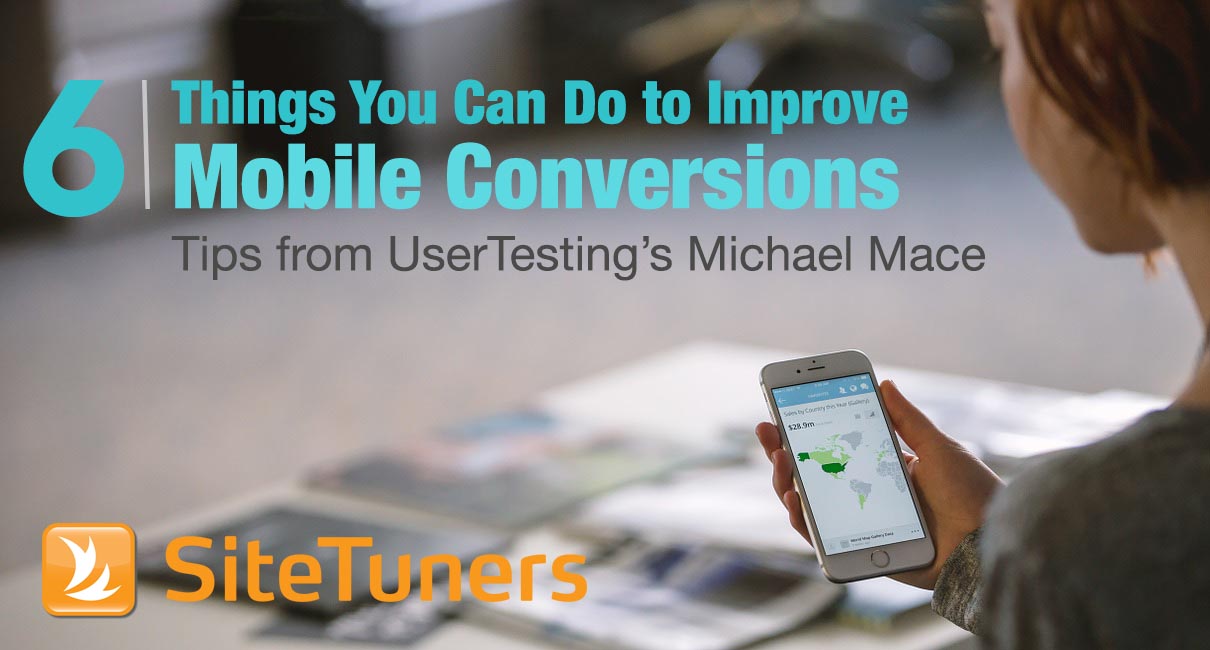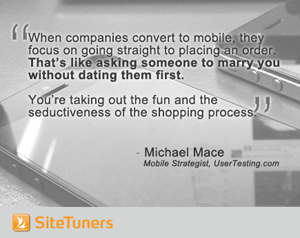 Smartphones don’t convert as well compared to desktops – smartphone conversion rate is pegged at about 1 percent. Low mobile conversions may be attributed to small screen limitations, slower connections, and currently underpowered hardware. However, while he agrees that there are some inherent things about mobile, UserTesting’s Mobile Strategist Michael Mace says that tests show that when mobile doesn’t convert, it’s because the shopping process isn’t set up properly.
Smartphones don’t convert as well compared to desktops – smartphone conversion rate is pegged at about 1 percent. Low mobile conversions may be attributed to small screen limitations, slower connections, and currently underpowered hardware. However, while he agrees that there are some inherent things about mobile, UserTesting’s Mobile Strategist Michael Mace says that tests show that when mobile doesn’t convert, it’s because the shopping process isn’t set up properly.
SiteTuners CEO Tim Ash recently caught up with Michael on an episode of Landing Page Optimization, and the latter had the following to share on optimizing mobile user experience:
1. Prioritize tasks
Put things you think people are most likely to do on mobile upfront and accessible through the first screen. Michael says you can still make other things accessible, but you can hide them a few layers down where power users can find them.
2. Label things clearly
If there’s any doubt about whether people will know what a button or icon means, put a text label under it. Michael says that it might not “look as sexy, but the sexiest is a site that’s actually usable.”
3. Make the shopping experience fun and keep people engaged
A lot of people do online shopping because it’s fun. Michael notes that a lot of companies, when they convert to mobile, are too focused on simplifying and going straight to “Place an Order.” He says this is similar to asking someone to marry you without taking them out on a date – it’s “taking out the fun and seductiveness of the shopping process.”
You also have to hold people’s attention by showing them that they’re making progress rapidly doing their shopping task.
4. Provide product details
According to Michael, when they do tests, people say that they don’t have the full information available to them on mobile. Additional photos and other pertinent product information available on desktop are missing on mobile, so people feel they don’t have the data they need to make a decision.
On mobile, you still need the context and all of the details; they just have to be represented differently. There’s got to be the main path of checking out, but the details still have to be there and should be easily accessible.
5. Give users an out
Give people the option to go to the full site. However, Michael warns that the web version should not be used as a crutch. He says the native mobile experience should be as good as it can possibly be.
There’s also value in putting click-to-call since people look for a help function when they get stuck in a mobile setting. Michael says that whether it’s click-to-call or having a few screens that can be swiped through that show how the controls work in the site, there should be some help function that people can use to get back on track when they get confused.
6. Be clear about security and opt-ins
Michael notes that people tend to be more afraid of scammers and of accidentally opting in on mobile. So while he’s all for social log-ins because it’s convenient and it simplifies the checkout process, he stresses the importance of being explicit about what you’re going to do with people’s information. For example, tell people who are logged in through Facebook that you’re not posting anything on their page on their behalf. Assume that people are going to assume that you’re going to do something underhanded, so address that concern upfront immediately.
Work with the best!Kickstart your optimization with a 90-minute Website Review from the pioneers in conversion rate optimization. Our CRO experts at SiteTuners can help diagnose your website from a conversion and usability perspective. |


